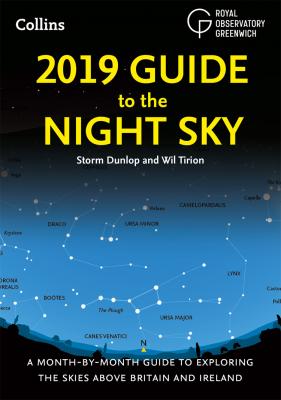ТОП просматриваемых книг сайта:
2019 Guide to the Night Sky: Bestselling month-by-month guide to exploring the skies above Britain and Ireland. Wil Tirion
Читать онлайн.Год выпуска 0
isbn 9780008311643
Автор произведения Wil Tirion
Жанр Справочная литература: прочее
Издательство HarperCollins
The planets
Because the planets are always moving against the background stars, they are treated in some detail in the monthly pages and information is given when they are close to other planets, the Moon or any of five bright stars that lie near the ecliptic. Such events are known as appulses or, more frequently, as conjunctions. (There are technical differences in the way these terms are defined – and should be used – in astronomy, but these need not concern us here.) The positions of the planets are shown for every month on a special chart of the ecliptic.
The term conjunction is also used when a planet is either directly behind or in front of the Sun, as seen from Earth. (Under normal circumstances it will then be invisible.) The conditions of most favourable visibility depend on whether the planet is one of the two known as inferior planets (Mercury and Venus) or one of the three superior planets (Mars, Jupiter and Saturn) that are covered in detail. (Some details of the fainter superior planets, Uranus and Neptune, are included in this Guide, and special charts for both are given here and here.)
Inferior planet.
The inferior planets are most readily seen at eastern or western elongation, when their angular distance from the Sun is greatest. For superior planets, they are best seen at opposition, when they are directly opposite the Sun in the sky, and cross the meridian at local midnight.
It is often useful to be able to estimate angles on the sky, and approximate values may be obtained by holding one hand at arm’s length. The various angles are shown in the diagram, together with the separations of the various stars in the Plough.
Meteors
At some time or other, nearly everyone has seen a meteor – a ‘shooting star’ – as it flashed across the sky. The particles that cause meteors – known technically as ‘meteoroids’ – range in size from that of a grain of sand (or even smaller) to the size of a pea. On any night of the year there are occasional meteors, known as sporadics, that may travel in any direction. These occur at a rate that is normally between three and eight in an hour. Far more important, however, are meteor showers, which occur at fixed periods of the year, when the Earth encounters a trail of particles left behind by a comet or, very occasionally, by a minor planet (asteroid). Meteors always appear to diverge from a single point on the sky, known as the radiant, and the radiants of major showers are shown on the charts. Meteors that come from a circular area 8° in diameter around the radiant are classed as belonging to the particular shower. All others that do not come from that area are sporadics (or, occasionally from another shower that is active at the same time). A list of the major meteor showers is given here.
Superior planet.
Although the positions of the various shower radiants are shown on the charts, looking directly at the radiant is not the most effective way of seeing meteors. They are most likely to be noticed if one is looking about 40–45° away from the radiant position. (This is approximately two hand-spans as shown in the diagram for measuring angles.)
Other objects
Certain other objects may be seen with the naked eye under good conditions. Some were given names in antiquity – Praesepe is one example – but many are known by what are called ‘Messier numbers’, the numbers in a catalogue of nebulous objects compiled by Charles Messier in the late eighteenth century. Some, such as the Andromeda Galaxy, M31, and the Orion Nebula, M42, may be seen by the naked eye, but all those given in the list will benefit from the use of binoculars. Apart from galaxies, such as M31, which contain thousands of millions of stars, there are also two types of cluster: open clusters, such as M45, the Pleiades, which may consist of a few dozen to some hundreds of stars; and globular clusters, such as M13 in Hercules, which are spherical concentrations of many thousands of stars. One or two gaseous nebulae, consisting of gas illuminated by stars within them, are also visible. The Orion Nebula, M42, is one, and is illuminated by the group of four stars, known as the Trapezium, which may be seen within it by using a good pair of binoculars.
Meteor shower (showing the April Lyrid radiant).
Measuring angles in the sky.
Some interesting objects.
| Messier / NGC | Name | Type | Constellation | Maps (months) |
| — | Hyades | open cluster | Taurus | Sep. – Apr. |
| — | Double Cluster | open cluster | Perseus | All year |
| — | Melotte 111 (Coma Cluster) | open cluster | Coma Berenices | Jan. – Aug. |
| M3 | — | globular cluster | Canes Venatici | Jan. – Sep. |
| M4 | — | globular cluster | Scorpius | May – Aug. |
| M8 | Lagoon Nebula | gaseous nebula | Sagittarius | Jun. – Sep. |
| M11 | Wild Duck Cluster | open cluster | Scutum | May – Oct. |
| M13 | Hercules Cluster | globular cluster | Hercules | Feb. – Nov. |
| M15 | — | globular cluster | Pegasus | Jun. – Dec. |
| M22 | — | globular cluster | Sagittarius |

